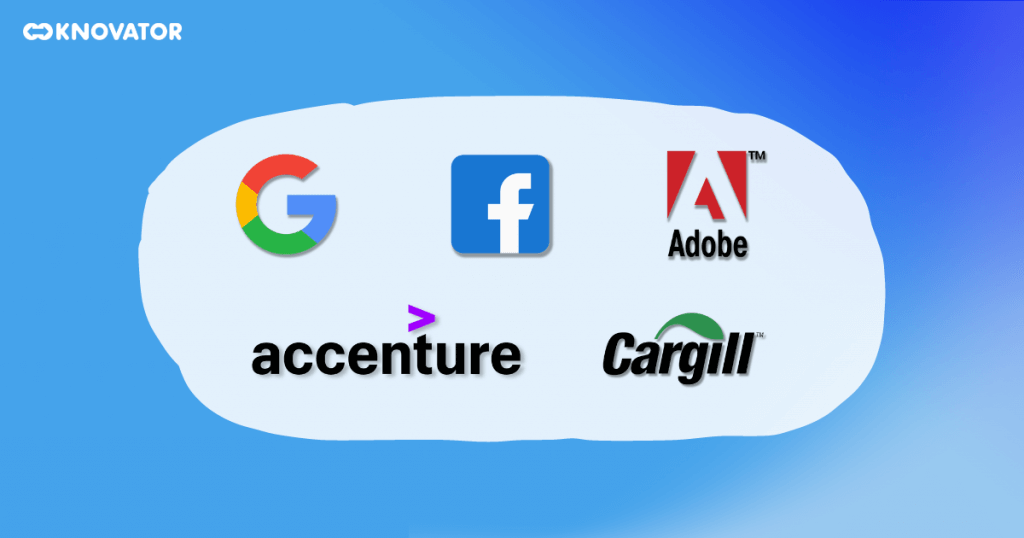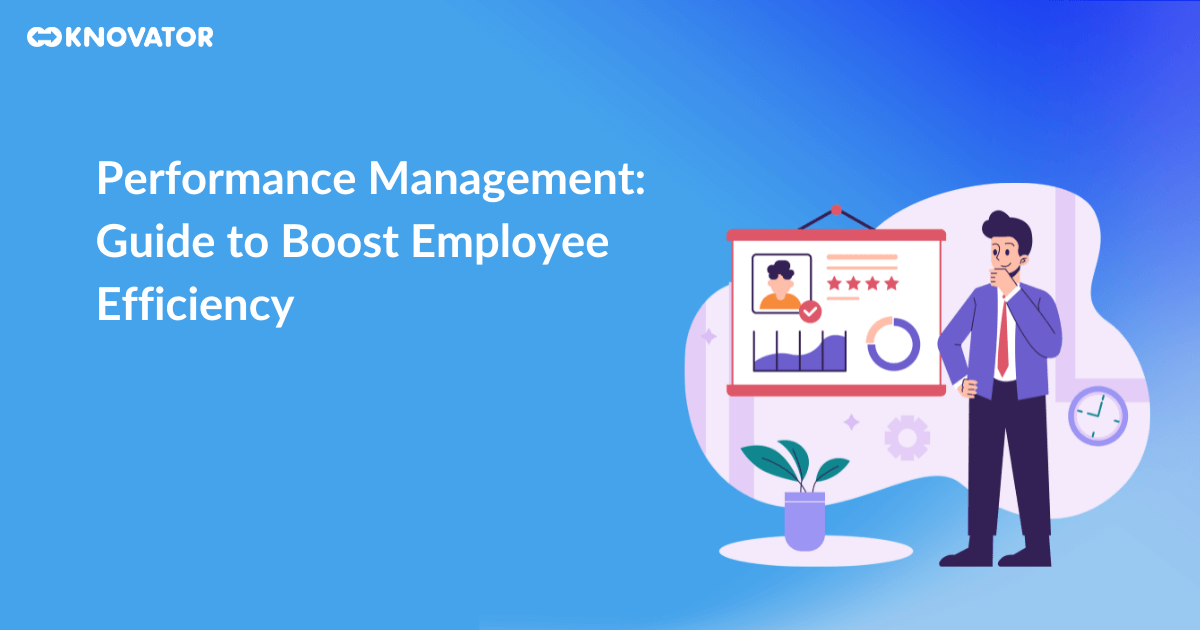Do you know that, as per research, old methods like yearly reviews no longer help and can even make employees less excited about work?
So, what can be done to boost employee effectiveness?
To boost employee effectiveness, several companies are adopting performance management.
This smart and planned approach to making employees better at their jobs is becoming more popular in companies of all sizes, including many of the most famous ones, like Fortune 500 and top industry leaders.
But what if you are a beginner? Don’t worry; this blog will study the benefits, real-life examples, and many more things related to performance management.
Let’s begin!
What is Performance Management?

By helping employees grow and match company goals with their own, bosses can build a place where everyone does well.
So, based on this idea, companies plan to measure and improve the performance of employees. In practice, performance management means bosses are always helping employees improve, set clear goals, and give feedback all year. Unlike other ways to look at employee performance, like yearly reviews, this is much more active and brings better results.
Performance management is a significant system within the Human Resources department that aims to support, engage, retain, and evaluate employees.
The shift is happening: yearly reviews are getting a makeover. These reviews need more power to engage employees truly, occasionally fall short of company objectives, and often fail to provide an accurate picture of employee performance.
Importance of Performance Management

- Clear Goals and Focus: Performance management sets clear goals for everyone. When everyone knows what they’re working towards, they can focus better and do their jobs well.
- Growth and Learning: With performance management, employees keep getting better at what they do. They learn new things and become more skilled, which helps the company too.
- Better Communication: Performance management ensures bosses and employees communicate about work. It helps in solving problems and knowing what’s going on.
- Motivation and Satisfaction: Employees who see their progress and get feedback feel good about their work. It makes them happier and more motivated to do their best.
- Improved Results: The company does better when everyone works well and is motivated. It’s like a cycle of success.
- Recognizing and Rewarding: Performance management ensures that good work is noticed. People get recognized and rewarded for their efforts.
- Employee Development: Companies can help employees learn and grow with performance management. It means they become even better at their jobs.
- Employee Retention: Employees who feel valued and see their growth are likely to stay in the company. It saves the company from losing skilled people.
- Aligning with Company Goals: Performance management links what employees do with what the company wants to achieve. It ensures everyone is working towards a single goal.
- Continuous Improvement: It’s not just a one-time thing. Performance management is ongoing, so everyone keeps getting better and better.
As per Forbes, companies that set performance goals every three months see 31% more positive results from their performance process than those that do it once a year. And those who do it each month achieve even better outcomes.
Performance Management vs. Performance Appraisals
Here are the differences between performance management and performance appraisals:
Best Practices in Performance Management

1. Define the goals of your performance management efforts
As you create a plan for performance management, it’s important to know what you want to achieve. These questions can help:
- Do you want people to get more work done?
- Does your company want to find and train future leaders from its employees?
- Are you trying to make sure employees stay happy and want to keep working here?
When you know what you want your plan to do, it’s easier to make it that way.
2. Define and describe each role
When employees learn exactly what’s expected from them, how to do their tasks, and what the outcome should be like, it’s easier for them. Clarity about their role is super important for their success.
3. Combine goals with a performance plan
When you create goals, make sure also to create a performance plan to go with them. Big goals for the whole year can be hard to achieve because they seem too huge, and employees might feel stressed even before they begin. A performance plan helps them see the steps they need to take, making it much more likely that they will reach their goal.
4. Track progress toward performance goals
Keep an eye on how well employees are doing with their goals. Look at the important things you’re supposed to do. Use numbers and data to see if they’re getting closer to your goals. This way, you can catch problems early and make changes if needed.
5. Do regular Coaching
Coaching should happen often. Coaching aims to find and fix problems before they become big issues. If coaching doesn’t happen often, it won’t be very helpful. Regular monthly meetings or every few months help employees stay on the right path.
6. Make use of guidelines to your benefit
Make rules that guide each job at the beginning of the performance process. These rules should say what employees can and can’t do. They help employees know where to try new things and where to follow the rules. When people have clear rules, they can do their jobs better.
7. Create a performance-driven culture
Create a work environment where everyone agrees on the same values and the work process. When employees share common beliefs and expectations, the workplace becomes friendlier and more peaceful. Employees should believe in and follow the goals and values set by the leaders at the top.
8. Arrange cross-functional workshops
Arrange workshops where people from different departments come together. It helps employees, including managers, learn about what other departments do, how they work, and what they’re good at or not so good at. It’s a chance to find out new things and make connections that can be useful in the future.
9. Management must provide actionable feedback
Problems can arise if the advice isn’t given in a way that helps. It’s not so important to talk about the past and blame someone. Instead, managers should help employees do better in the future.
10. Keep it professional, not personal
Giving only partially positive feedback is tough for managers and employees. Thus, performance evaluations are often disliked. As a manager, you must give feedback professionally and remember to talk about actions, not personal qualities.
For instance, if you talk about how John often gives important reports late, that’s about what he did, which is an action. But if you say John is lazy, that’s about his personal quality. The first one helps John understand his part in whether a project goes well or not. The other makes him feel like he has to defend himself.
So, these were the best practices of performance management.
Real-world Examples of Performance Management

1. Google
It’s not a surprise that Google, a company known for being innovative, stands out in using a new way of managing its people. They’re always leading the way, and how they manage performance is special. They rely on data and analyzing information and ensure their managers are well-prepared.
When they look at how well their managers do, Google launched a special project. This project checks how managers are doing and helps them learn and improve. This training sets up managers and their teams to do well.
They also have a way of setting goals that’s become famous in many industries. It’s called OKRs, which stands for “Objectives and Key Results.” This system changes how goals are set, and it’s been successful.
2. Facebook
Facebook, like other tech leaders, has a unique way of managing how people do their work. They focus a lot on peer feedback, which means colleagues share their thoughts. Every six months, they use this feedback to check how teams are doing and determine where people work together well and where they need to improve.
They even made a special tool that lets employees always give feedback. This tool helps fix small issues before they turn into big ones. This way, things stay smooth, and everyone works better together.
3. Cargill
Cargill, a big food company from Minnesota with many employees, shows that even large companies can change their old way of doing performance evaluations. They did this by creating something new called ‘Everyday Performance Management.’ This way, they listen to the research saying that many managers prefer a different way of doing evaluations.
Their new system is all about keeping things ongoing. It’s focused on building a good relationship between employees and managers. They talk daily, which helps solve problems and give feedback. Instead of discussing the past, they work on what’s happening now.
This new system worked well. Around 69% found the feedback useful for their growth, and about 70% felt valuable because of the continuous talks with their managers.
4. Adobe
Adobe is a company that’s been widely talked about because it changed how they manage performance. Their numbers show that giving feedback often and regularly discussing it with employees is a good idea. They introduced this new way and saw that the percentage of employees leaving decreased by about 30%.
Such a thing happened because of their new system. Now, managers and bosses talk regularly with employees who might be having a hard time at work. It is different from waiting for a special review time. So, while more people left because of their performance, it helped the company do better.
5. Accenture
Accenture is a big company with many people – more than 330,000! They made a big effort to change how they do things. They eliminated about 90% of their old process when they made the change. Now, they do things more flexibly. Employees get feedback from managers all the time. They also care a lot about helping employees grow and improve, and they have a special app for sharing feedback.
All these examples have something in common. Each company made a system that fits them best instead of using a one-size-fits-all approach. What’s good for one company might not be good for another. It depends on the type of business, how fast the company moves, and what they want the system to achieve.
Rethink Performance Management for Success
Changing how companies handle performance isn’t just a fad; it’s a smart move that can change things. Big companies like Google, Cargill, and Accenture show how special plans matching a company’s needs can make a huge difference. They listen and talk to their employees all the time. They make sure everyone gets better and knows their value. There’s no single way for all companies to do this – it’s about finding what fits them best.
This means being flexible and adjusting how they help their employees based on what works for them. This change isn’t just good for employees; it also improves the whole company’s performance.
As a business, you’ll do even better by making unique performance plans matching your goals.








